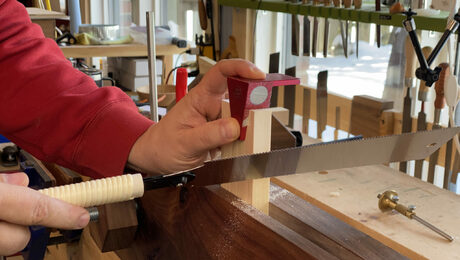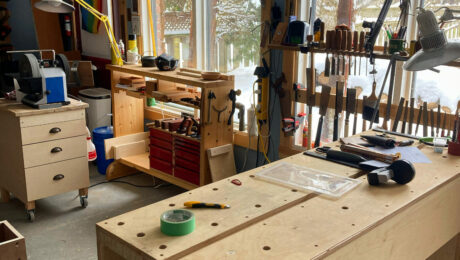Simple jigs
Whether you build beautiful jigs or quick and dirty ones like Vic, the work they do is critical.
There is no doubt that jigs and fixtures are extremely helpful for many operations in woodworking. But what exactly is a jig or fixture and why are they so helpful? First let’s consider the difference between the two.
Jigs vs. fixtures
Jigs control and guide a cutting tool to work on a workpiece, whereas fixtures are used for supporting and locating a workpiece. In practical terms, a dovetail saw guide is considered a jig because it guides the cutting tool (the saw) through the wood to create the angled cut we all know and love.
Fixtures often get seen in machining operations. For example, if you are into CNC woodworking, a fixture would locate and support a piece of wood while a machine works on the piece. Fixtures are generally immobile while jigs are portable.
I use jigs more often in my woodworking for both hand- and power-tool applications. There are two schools of thought when it comes to the making of these jigs. Some folks like to make them to furniture quality—nice wood or Baltic birch, and nice fixings like stainless steel or brass. On the other end of the spectrum (where I find myself), you have jigs that are slapped together with scrap bin pieces, all held together with globs of hot glue, pins, and screws.
Necessity vs. quality
In my own workflow, I don’t often use a jig beyond its initial requirements. I don’t make jigs to be reused over and over because I don’t often make the same thing twice. The exception is if I make jigs for teaching classes. These need to be well built and reusable because they will be used many times by many people. However often the jig will be used, I still usually just use up scraps to make it.
The pictured simple jig is used to make solid-wood bow ties to stabilize natural cracks in wood. As you can see, it’s made from an old scrap of crumby cabinet-grade plywood. The jig is large enough to create a huge bow tie if needed but can also be used for smaller, more delicate ones. It took about 2 minutes to make the jig and will likely be the only one I will ever have to build. I put a bit of wax on the running edge and surface but other than that, it’s pretty low maintenance.
I’ve seen many adjustable jigs in the past but I’m not a fan of them. I find they take a long time to build and have to be well-built to stand the test of time. The one that comes to mind is an adjustable table for the drill press which helps to drill angled holes. I prefer to make a couple of wedges, attach a surface that will act as a table, and then use it for the project. It takes five minutes or so to build then gets recycled when I’m done with it.
Means to an end
Regardless, jigs and fixtures can be a huge time saver, and more importantly, can ensure accuracy when you need it most. Whether you build beautiful jigs or quick and dirty ones like me, the work they do is critical.
If you want to see this jig in action, check out this YouTube video.
 |
The case for hand-cut dovetails |
 |
Are you a wood shop tweaker? |
 |
Clean as you go |
Fine Woodworking Recommended Products

Double Sided Tape

Woodriver Circle Cutting Jig

Hedgehog featherboards























Comments
Very nice! But can't you just draw it up on the ply and freehand cut it on the bandsaw? Smooth it down with rasp and sandpaper?
Log in or create an account to post a comment.
Sign up Log in